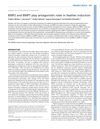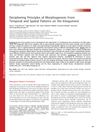TLDR Birds can lose neck feathers due to a genetic change that increases a gene's activity, helping them adapt to heat.
The study explored the developmental mechanisms behind the loss of neck feathering in birds, focusing on the Naked neck mutation in chickens. Researchers identified a large genetic insertion linked to this trait, which led to increased expression of the BMP12/GDF7 gene in embryonic skin. This gene, part of the BMP family, inhibits feather formation through a reaction-diffusion mechanism. The study found that neck skin selectively produces retinoic acid, enhancing BMP signaling and making it more sensitive to feather suppression compared to body skin. This cryptic patterning allows for the evolutionary adaptation of a bare neck while maintaining feathering on the body, contributing to heat tolerance in birds.
 88 citations
,
July 2008 in “Development”
88 citations
,
July 2008 in “Development” BMP2 and BMP7 have opposite roles in feather formation.
193 citations
,
May 2008 in “Development” Activating β-catenin can turn skin cells into hair follicles.
 25 citations
,
September 2006 in “Birth Defects Research”
25 citations
,
September 2006 in “Birth Defects Research” Different processes create patterns in skin and things like hair and feathers.
66 citations
,
June 2004 in “Development” FGF signaling is crucial for starting feather development in chicken embryos.
 133 citations
,
February 2019 in “PLoS Biology”
133 citations
,
February 2019 in “PLoS Biology” Feather patterns in birds are shaped by signaling interactions and cell movements, with EDA/EDAR crucial for pattern formation.
 47 citations
,
May 2012 in “Wiley Interdisciplinary Reviews-Developmental Biology”
47 citations
,
May 2012 in “Wiley Interdisciplinary Reviews-Developmental Biology” The conclusion is that understanding how feathers and hairs pattern can help in developing hair regeneration treatments.
 19 citations
,
April 2015 in “Developmental Dynamics”
19 citations
,
April 2015 in “Developmental Dynamics” The conclusion is that skin and hair patterns are formed by a mix of cell activities, molecular signals, and environmental factors.
 5 citations
,
February 2019 in “PloS one”
5 citations
,
February 2019 in “PloS one” Bald thigh syndrome in sighthounds is caused by structural defects in hair shafts due to downregulated genes and proteins.
112 citations
,
January 2004 in “The International journal of developmental biology” Feather patterns form through genetic and epigenetic controls, with cells self-organizing into periodic patterns.





